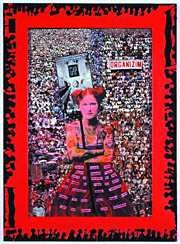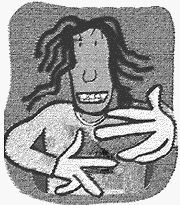LAST WINTER’S anti-WTO protests were some of the best and most inspiring actions I’ve seen humans take in my lifetime. Now, it’s probably because I have a reputation as a cynical old bastard, but when I express this opinion to people they always seem surprised that my feelings are so unequivocally positive. On the other hand, maybe it’s just because my thoughts contradict the TV coverage, which portrayed the action either as a failed attempt by boring activists to maintain a civil discourse or a successful attempt by demonic and “self-avowed” anarchists to deprive Seattle taxpayers of five crucial days of holiday shopping. Or both. (And, by the way, let me just say that the term “self-avowed” is redundant, and its constant use by commentators only served to suggest that TV people consider their viewers too stupid to know what the word “avowed” means. Plus, some of the nicest people I know are avowed anarchists. Anyway. . . .)
Really, though, who in this day and age seriously expected the mass media to give objective coverage to what was essentially an anticapitalist uprising? I don’t know what it says about our society that we have to turn to art for unbiased reporting, but I’m not complaining, because this month Seattle is enjoying a number of works of art, music, and film that both reflect and embody the spirit of the anti-WTO movement.
VISUAL ARTS
“The Whole World Is Watching: Art, Images + Literature from the WTO Protests” runs at the Center on Contemporary Art (CoCA) through July 1 (in conjunction with several events at the Independent Media Center and the 911 Media Arts Center). The show creatively juxtaposes representative art (that is, art about the protests) with functional art (art that was actually used in the protests), subtly erasing the distinction between reportage and participation. As with the protests themselves, there’s a refreshingly broad palette to choose from: a photo of the Lusty Lady’s marquee (“Nude World Order”) shares space with a large papier-m⣨頢usinessman, an autographed door (from an anarchist squat), and a huge, collectively produced graffiti-influenced mural. How’s that for multiple perspectives?
Perhaps the most thought-provoking piece is “Take Off the Head,” which presents 525 woodcut-style portraits of politically influential figures, from Nigeria’s Olusegun Obasanjo to Arkansas’ Paula Jones, without specifying their relationships to each other or the WTO. The implicit message—”Figure it out yourself!”—is not so much a challenge as an invitation, and as such represents the grassroots spirit of the protests far better than anything presented on television during that exciting week last December.
FILM
That news coverage—thankfully—is used sparingly in Trade Off, a documentary about the anti-WTO protests that won Best Documentary at this year’s Seattle International Film Festival’s Golden Space Needle awards (and may gain wider release this summer). The film—the first feature from director Shaya Mercer—manages to balance political content, humor, and striking images, such as a fast 360-degree pan at the intersection of Fourth and Pike that reveals colorful crowds stretching to the horizon in all directions. Mild-mannered and hilarious activist Mike Dolan becomes a de facto narrator as interview segments are interspersed with footage of relevant images. Early in the film he expresses his commitment to the struggle by looking directly at an interviewer and deadpanning, “I have TWO cell phones, all right?” The one potential disappointment for Seattle audiences derives from the film’s focus on the broad political implications of the protest. Having made that (quite reasonable) choice, it tends to steer clear of items that may be more superficially colorful or of greater local interest: The conflagrations that occurred when police clashed with crowds on Capitol Hill, for instance, are not mentioned at all.
MUSIC
Meanwhile, on the musical front, we have a CD from the No WTO Combo: Live from the Battle in Seattle (on Alternative Tentacles Records). The NWTOC was a one-off project featuring Krist Novoselic of Nirvana and Sweet 75 on bass, Gina Mainwal of Sweet 75 on drums, Kim Thayil of Soundgarden on guitar, and Jello Biafra of the Dead Kennedys as the lyric-spewing vocalist. Originally scheduled to play on the first night of the protests, the band was put off by the tear gas and general mayhem. They did perform the next night, though, and this recording documents that show. Those who braved Paul Schell’s bizarre partial curfew (“Protesters will be met with tear gas and rubber bullets, but if you’re here to shop, everything’s hunky dory!” What if I wanted to do both?) were treated to a set of pure energy embodied in music. As Jello aptly proclaims in the 15-minute tirade that introduces the CD, “The cardboard turtle insurrection has begun!” The music mixes relevant old favorites from Jello with WTO-specific new songs all wrapped in Paris ’68, behind-the-barricades joie de vivre. If that’s not punk rock, I don’t know what is. . . .
INTERNET
The No-WTO Combo’s performance also forms the centerpiece of “This Is What Democracy Looks Like,” a six-minute documentary currently being Webcast on www.fbgc.com. Actually, it’s not really clear whether the piece is a documentary with background music from the combo or a music video that utilizes WTO footage, but that ambiguity is itself intriguing. The Fastband Globalcast, under whose auspices the documentary appears, was founded by Novoselic and Roderick Romero of Sky Cries Mary as an attempt to blur the line between documentary, political action, and art. Initially Webcasting from New Orleans, the Globalcast soon plans to feature continuous Internet transmissions from studios in Los Angeles, Amsterdam, Edinburgh, Rio de Janeiro, Bangkok, and Sydney.
TAKEN COLLECTIVELY, these works paint a picture of a world in transition. The portrayal of this movement by a variety of media, each operating from a different perspective, serves to underline its nondogmatic, nonhierarchical nature. And that may be the best part of all: I have to refer to it as “this movement” because it doesn’t really have a name; it is so decentralized that no single term, slogan, or ideology will suffice. There is no one leader/spokesmodel to be idolized, imitated, and ultimately co-opted. There is no one book or song or movie or painting that can explain it. Make your own art. Make your own life. Or, as Billy Bragg once sang, “Start your own revolution—cut out the middleman.”






